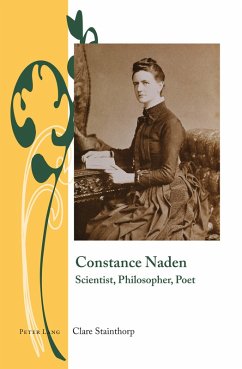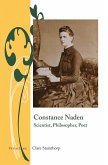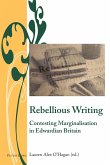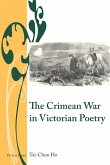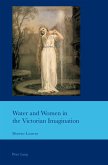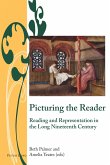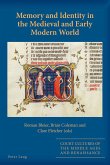Constance Naden (1858-1889) is a unique voice in Victorian literature and science. This book, the first full-length critical account of her life and works, brings into focus the reciprocal nature of Naden's poetry, philosophical essays and scientific studies. The development of Naden's thinking is explored in detail, with newly discovered unpublished poems and notes from her adolescence shedding important light upon this progression.
Close readings of Naden's wide-ranging corpus of poetry and prose trace her commitment to an interdisciplinary world-scheme that sought unity in diversity. This book demonstrates how a rigorous scientific education, a thorough engagement with poetry and philosophy of the long nineteenth century, an involvement with the Victorian radical atheist movement, and a comic sensibility each shaped Naden's intellectual achievements. Naden sought to show how the light of reason is made even brighter by the spark of poetic creation and how the imagination is as much a tool of the scientist and the philosopher as the artist.
Taking a comprehensive approach to this complex and overlooked figure of the Victorian period, Stainthorp demonstrates how Naden's texts provide a new and important vantage point from which to consider synthetic thinking as a productive and creative force within nineteenth-century intellectual culture.
This book was the winner of the 2017 Peter Lang Young Scholars Competition in Nineteenth-Century Studies.
Close readings of Naden's wide-ranging corpus of poetry and prose trace her commitment to an interdisciplinary world-scheme that sought unity in diversity. This book demonstrates how a rigorous scientific education, a thorough engagement with poetry and philosophy of the long nineteenth century, an involvement with the Victorian radical atheist movement, and a comic sensibility each shaped Naden's intellectual achievements. Naden sought to show how the light of reason is made even brighter by the spark of poetic creation and how the imagination is as much a tool of the scientist and the philosopher as the artist.
Taking a comprehensive approach to this complex and overlooked figure of the Victorian period, Stainthorp demonstrates how Naden's texts provide a new and important vantage point from which to consider synthetic thinking as a productive and creative force within nineteenth-century intellectual culture.
This book was the winner of the 2017 Peter Lang Young Scholars Competition in Nineteenth-Century Studies.
Dieser Download kann aus rechtlichen Gründen nur mit Rechnungsadresse in A, D ausgeliefert werden.
«This book represents a much-needed, full-length study of the brilliant intellectual trail Constance Naden blazed as a student and scholar: of the many facets of her brilliant career, and of her expansive synthetic mode of thinking. Naden's career interlaced so many issues and disciplines in such a fascinating way that, in this timely work, she acts as a case study for thinking about the value and practice of interdisciplinarity itself. This is an astute, lucid and illuminating analysis.» (Marion Thain, Professor of Literature and Culture, King's College London)
«Stainthorp's study of Constance Naden both reveals and revels in the interdependence of disciplines that was her subject's tragically short-lived contribution to nineteenth-century thought. In doing so she thoughtfully synthesizes the variant parts of Naden's intellectual life. The result is a book of insightful combinations and cross-readings which illuminate the unity in diversity that was Naden's driving force.» (Martin Willis, Professor of English Literature, Cardiff University and editor of the Journal of Literature and Science)
«This is an important, meticulously researched book. Stainthorp is marvellously alert to Naden's desire to find unity in diversity in her writing. She puts Naden's poetry, prose and unpublished notebooks to work and the result is a ground-breaking analysis of Naden's synthetic thinking. A boon to scholars working on Naden.» (Ana Parejo Vadillo, Reader in Nineteenth-Century Literature and Culture, Birkbeck College, University of London)
«This is a rich, suggestive, and long overdue study of a life cut tragically short, and an insightful study of the intellectual intersections of multiple disciplines in the 1880s. Stainthorp achieves a powerful recalibration of Naden's life and career, and promises to inspire a slew of further studies on this fascinating figure. Equally, it yields an important case study on the issue of interdisciplinarity at a critical period in its history, and a specific and particularly ambitious approach to the longheld problem of achieving 'unity in diversity'.» (Adelene Buckland, Women: A Cultural Review, Vol. 31, No. 3)
«Stainthorp's study of Constance Naden both reveals and revels in the interdependence of disciplines that was her subject's tragically short-lived contribution to nineteenth-century thought. In doing so she thoughtfully synthesizes the variant parts of Naden's intellectual life. The result is a book of insightful combinations and cross-readings which illuminate the unity in diversity that was Naden's driving force.» (Martin Willis, Professor of English Literature, Cardiff University and editor of the Journal of Literature and Science)
«This is an important, meticulously researched book. Stainthorp is marvellously alert to Naden's desire to find unity in diversity in her writing. She puts Naden's poetry, prose and unpublished notebooks to work and the result is a ground-breaking analysis of Naden's synthetic thinking. A boon to scholars working on Naden.» (Ana Parejo Vadillo, Reader in Nineteenth-Century Literature and Culture, Birkbeck College, University of London)
«This is a rich, suggestive, and long overdue study of a life cut tragically short, and an insightful study of the intellectual intersections of multiple disciplines in the 1880s. Stainthorp achieves a powerful recalibration of Naden's life and career, and promises to inspire a slew of further studies on this fascinating figure. Equally, it yields an important case study on the issue of interdisciplinarity at a critical period in its history, and a specific and particularly ambitious approach to the longheld problem of achieving 'unity in diversity'.» (Adelene Buckland, Women: A Cultural Review, Vol. 31, No. 3)

